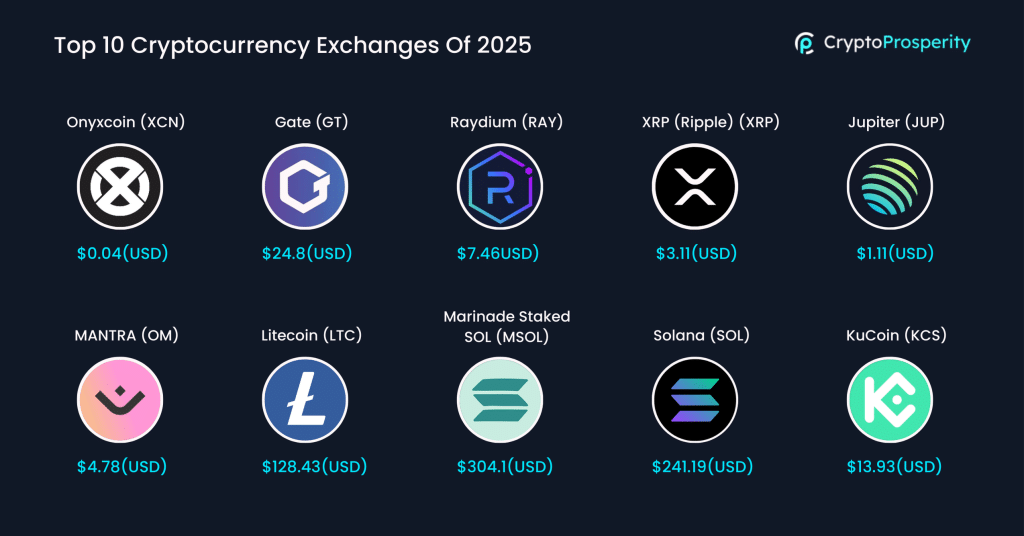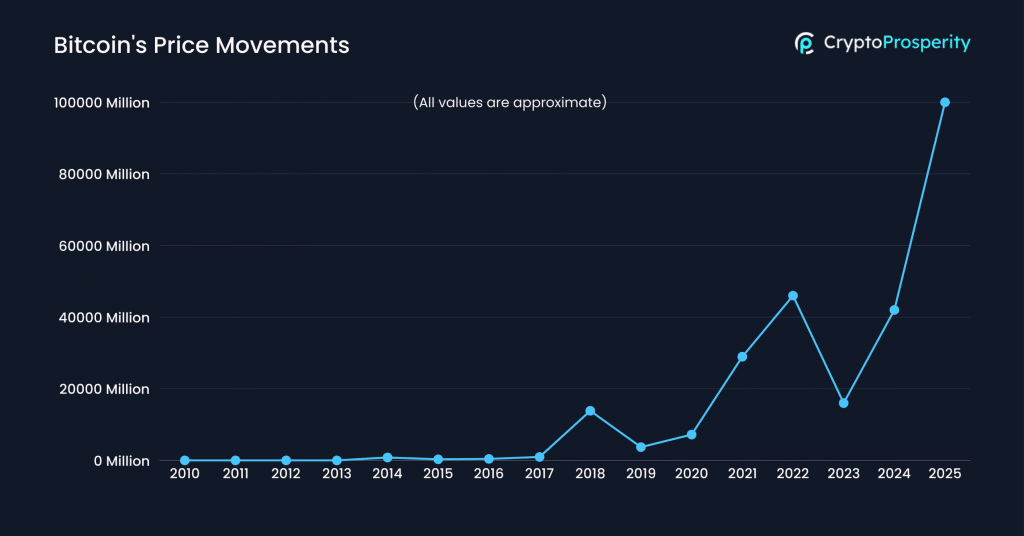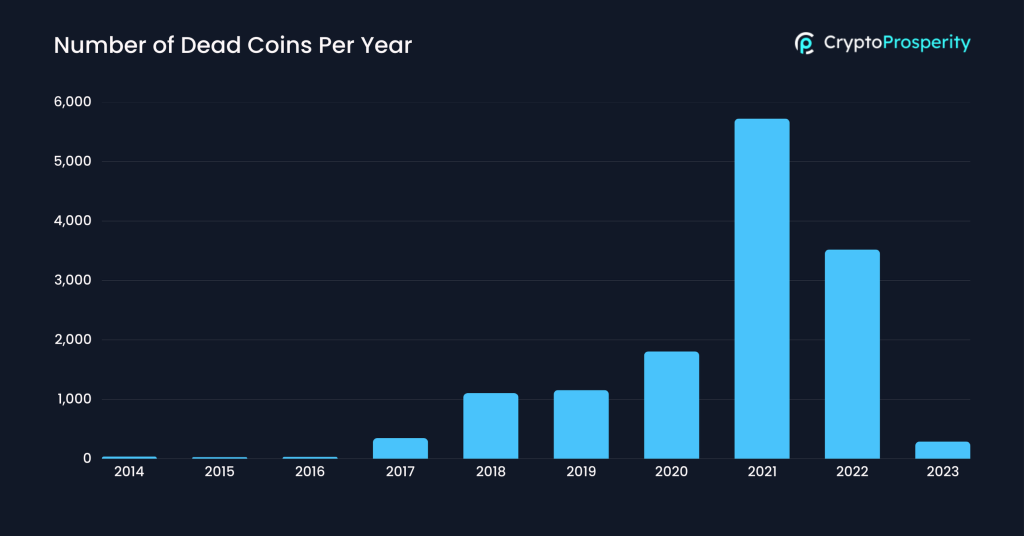What began as a single digital asset in 2009 has grown into a vast market with over 17,000 cryptocurrencies in circulation as of 2025.
However, only a fraction hold real value, with Bitcoin and Ethereum dominating nearly 75% of the market.
The global crypto market cap stands at $2.96 trillion, reflecting both growth and volatility. While over 50% of all cryptocurrencies have failed, innovation continues.
Exchanges like Binance lead the industry, and 28% of American adults now own digital assets. As adoption rises, blockchain technology is set to shape the future of finance. Find more details below!
Top Picks: How Many Cryptocurrencies Are There?
- As of 2025, 17151 cryptocurrencies are in existence. (Coin Gecko) However, the majority have low market significance.
- Bitcoin and Ethereum together account for nearly 75% of the total cryptocurrency market cap, highlighting the market’s concentration.
- As of 2025, Bitcoin (BTC) remains a “high cap” asset, with a market capitalization exceeding $10 billion, signifying its dominance in the crypto space. (Statista)
- 217 cryptocurrency exchanges exist worldwide in 2025. (Coin Gecko)
- The global cryptocurrency market cap stands at $2.96 trillion, reflecting both rapid growth and extreme volatility. (Coin Gecko)
- The worldwide cryptocurrency market is expected to generate $45.3 billion in revenue in 2025. The penetration rate is estimated at 11.02% worldwide by the end of 2025. (Statista)
- As of 2025, over 50% of all cryptocurrencies have failed. (Coin Gecko)
How Many Cryptocurrency Exchanges Are There?
- As of 2025, there are 217 cryptocurrency exchanges worldwide.
SuperEx is the largest cryptocurrency spot exchange in the world by trading volume, with $163.61 billion in trades within 24 hours. Binance, once the dominant exchange, ranks second with $15.41 billion in 24-hour trading volume.

Here’s a table of the top 10 cryptocurrency exchanges based on 24-hour trading volume as of 2025:
| Exchange | 24h Trading Volume (in Billion USD) |
|---|---|
| SuperEx | 163.61 |
| Binance | 15.41 |
| 4E | 3.52 |
| BiFinance | 3.32 |
| HTX | 2.99 |
| Darkex Exchange | 2.95 |
| Zedcex Exchange | 2.59 |
| Bybit | 2.47 |
| MEXC | 2.45 |
| OKX | 2.30 |
Cryptocurrency Market Size (2025-2030)
- As of 2025, the global cryptocurrency market cap today is $2.96 trillion.
- The peak Cryptocurrency market cap appears to be around $4 trillion, reached in late 2024.
- The lowest market cap in the last decade was before 2017, when the total market cap remained under $100 billion.
Here is a year-wise breakdown of the total cryptocurrency market capitalization:
| Year | Approx. Cryptocurrency Market Cap |
|---|---|
| 2015 | <$10 billion |
| 2016 | ~$15 billion |
| 2017 | ~$600 billion (Dec peak) |
| 2018 | ~$130 billion (Bear market low) |
| 2019 | ~$250 billion |
| 2020 | ~$750 billion (End of year) |
| 2021 | ~$3 trillion (Nov peak) |
| 2022 | ~$800 billion (Bear market low) |
| 2023 | ~$1.8 trillion |
| 2024 | ~$4 trillion (Peak) |
| 2025 | ~$2.96 trillion (Current) |
- By 2030, the cryptocurrency market is expected to reach USD 69.39 billion, reflecting a compound annual growth rate (CAGR) of 7.11%. (Mordor Intelligence)
Growth Of Crypto Coins Over The Years
- The global cryptocurrency user base grew the most by nearly 190% between 2018 and 2020. (Statista)
- As of January 30, 2025, Bitcoin (BTC) reached a price of $105,510, marking a 12.5% increase over the past 30 days. 30 days ago, Bitcoin was approximately $93,800.
- Ethereum (ETH) was priced at $3,217.96, reflecting a 4.6% drop in the past month.

Top 10 Performing Cryptocurrencies (30-Day Change) as of January 30, 2025:
| Rank | Cryptocurrency (Symbol) | Price (USD) | 30-Day % Change |
|---|---|---|---|
| 1 | Onyxcoin (XCN) | $0.04 | +1,550.7% |
| 2 | Gate (GT) | $24.8 | +55.1% |
| 3 | Raydium (RAY) | $7.46 | +51.7% |
| 4 | XRP (Ripple) (XRP) | $3.11 | +50.8% |
| 5 | Jupiter (JUP) | $1.11 | +35.3% |
| 6 | MANTRA (OM) | $4.78 | +34.2% |
| 7 | Litecoin (LTC) | $128.43 | +28.6% |
| 8 | Marinade Staked SOL (MSOL) | $304.1 | +26.7% |
| 9 | Solana (SOL) | $241.19 | +25.8% |
| 10 | KuCoin (KCS) | $13.93 | +30.0% |
(Statista)
- Bitcoin remains the most widely held cryptocurrency, owned by 74% of crypto investors.
- Ethereum ownership has declined from 65% in 2022 to 49% in 2025.
- Dogecoin ownership has increased to 31%, surpassing Solana (18%) and USDC (17%).
- 66% of people planning to buy crypto in 2025 want Bitcoin, followed by Ethereum (43%) and Dogecoin (24%).
- Solana has gained traction, with 17% of crypto buyers planning to invest in it this year.
- Ethereum recorded over 39 million on-chain transactions in December 2024, making it the most-used cryptocurrency that month.
- Bitcoin processed 12.7 million transactions in the same period, about one-third of Ethereum’s transaction volume.
(Statista)
Types of Cryptocurrency & Their Statistics
There are 12 types of Cryptocurrencies, and here are statistical facts about them:
1. Payment Cryptocurrencies
These are designed to function as digital money for transactions. (Examples: Bitcoin (BTC), Litecoin (LTC), Bitcoin Cash (BCH), Dash (DASH))
- Bitcoin (BTC) remains the largest payment-focused cryptocurrency, with a market cap of $1.75 trillion as of March 2025.
- Litecoin (LTC), often called the silver to Bitcoin’s gold, has a total supply of 84 million coins, four times that of Bitcoin.
2. Stablecoins
These are pegged to a stable asset like the U.S. dollar to minimize volatility. Examples: Tether (USDT), USD Coin (USDC), Dai (DAI), Binance USD (BUSD)
- Tether (USDT) is the most dominant stablecoin, with a market cap of $142.69 billion, making it the fourth-largest cryptocurrency overall.
- USD Coin (USDC) holds a $57.23 billion market cap and claims to be 100% backed by reserves.
3. Smart Contract Platforms
(These blockchains support decentralized applications (DApps) and automated contracts. Examples: Ethereum (ETH), Solana (SOL), Cardano (ADA), Avalanche (AVAX)
- Ethereum (ETH) leads this category with a $264.67 billion market cap and processes over 1 million transactions daily.
- Solana (SOL) boasts 65,000 transactions per second (TPS), making it one of the fastest blockchain networks.
4. Privacy Coins
These focus on enhanced anonymity and untraceable transactions. Examples: Monero (XMR), Zcash (ZEC), Dash (DASH), Verge (XVG)
- Monero (XMR) transactions are fully anonymous, with over 95% of transactions on its network being shielded from public view.
- Zcash (ZEC) offers optional privacy features and has been used in over 20 million transactions since its launch.
5. Utility Tokens
These provide access to specific services within a blockchain network. Examples: Chainlink (LINK), Binance Coin (BNB), Uniswap (UNI), Filecoin (FIL)
- Binance Coin (BNB) has a market cap of $84.33 billion and is widely used for trading fee discounts on Binance.
- Chainlink (LINK), a leading oracle network, has facilitated over $500 billion in innovative contract transactions.
6. Governance Tokens
These allow holders to vote on changes to a blockchain’s protocol. Examples: Maker (MKR), Aave (AAVE), Compound (COMP), Curve DAO (CRV)
- Maker (MKR) holders manage over $8 billion in assets within the MakerDAO ecosystem.
- Aave (AAVE) governance decisions impact a DeFi lending market worth over $10 billion.
7. Exchange Tokens
Issued by cryptocurrency exchanges, these tokens provide trading fee discounts and rewards. Examples: Binance Coin (BNB), FTX Token (FTT), OKB (OKB), KuCoin Token (KCS)
- Binance Coin (BNB) is the most valuable exchange token, worth $84.33 billion, and it is used for transaction discounts and payments.
- OKB (OKX Exchange token) has seen over 200% price growth in the last two years.
8. Meme Coins
These started as jokes but have gained value due to community support. Examples: Dogecoin (DOGE), Shiba Inu (SHIB), Pepe (PEPE), Floki Inu (FLOKI)
- Dogecoin (DOGE), originally a joke, now has a market cap of $29.84 billion and is used for payments, including Tesla merchandise.
- Shiba Inu (SHIB) has over 1.3 million holders, making it one of the most widely held meme tokens.
9. Gaming & Metaverse Tokens
Used in virtual worlds, gaming platforms, and NFT-based economies. Examples: Decentraland (MANA), Axie Infinity (AXS), The Sandbox (SAND), Gala (GALA)
- Since its launch, the Sandbox (SAND) has powered $500 million worth of virtual land sales.
- Axie Infinity (AXS) once processed $3 billion in NFT transactions in a year.
10. Layer 2 & Scaling Solutions
These improve blockchain efficiency by reducing transaction costs and congestion. Examples: Polygon (MATIC), Optimism (OP), Arbitrum (ARB), Loopring (LRC)
- Polygon (MATIC) processes more than 2.3 million daily transactions, reducing Ethereum gas fees significantly.
- Arbitrum (ARB) holds over $10 billion in total value locked (TVL) in DeFi protocols.
11. Central Bank Digital Currencies (CBDCs)
Government-issued digital currencies backed by national banks. Examples: Digital Yuan (e-CNY), Digital Euro, Digital Rupee, FedNow (U.S. proposal)
- China’s Digital Yuan (e-CNY) has over 260 million users and has completed $14 billion worth of transactions.
- More than 130 countries are exploring CBDCs, representing 98% of the global GDP.
12. Asset-Backed & Commodity Tokens
These represent ownership of real-world assets like gold, real estate, or stocks. Examples: Paxos Gold (PAXG), Tether Gold (XAUT), Synthetix (SNX), Wrapped Bitcoin (WBTC)
- Paxos Gold (PAXG) represents over $500 million in gold-backed assets on the blockchain.
- Wrapped Bitcoin (WBTC) has a circulating supply of over 160,000 BTC, bridging Bitcoin to Ethereum-based DeFi platforms.
(Coin Market, Coin Gecko, Etherescan, Bankrate, DefiLlama, PBC)
When Was Bitcoin Launched? (Bitcoin Statistics)
- Bitcoin was officially launched on January 3, 2009, by Satoshi Nakamoto, an anonymous creator or group.
- Bitcoin has seen multiple boom-and-bust cycles, often dropping 50-90% before rebounding stronger.
- In December 2024, Bitcoin crossed $100,000 for the first time, thanks to Donald Trump’s pro-crypto policies after his reelection.
- However, Bitcoin faced volatility in early 2025, dropping after announcing a Strategic Bitcoin Reserve.
- Bitcoin broke $100 for the first time in April 2013 and surged to over $1,200 by December.
- A 90% crash followed in 2014, largely due to the infamous Mt. Gox exchange collapse, dropping Bitcoin to $111 before rebounding to $430 by 2015.
- By 2017, Bitcoin skyrocketed past $10,000 in November, peaking at $19,000+ in December due to mainstream investor interest and hype.

Here’s a year-wise table summarizing Bitcoin’s historical price movements and returns:
| Year | Price at Start | Price at End | Return (%) |
|---|---|---|---|
| 2009 | N/A | N/A | N/A |
| 2010 | ~$0.00099 | ~$0.30 | 30,203%* |
| 2011 | ~$0.30 | ~$4.70 | 1,467% |
| 2012 | ~$4.70 | ~$13.50 | 187% |
| 2013 | ~$13.50 | ~$805 | 5,870% |
| 2014 | ~$805 | ~$318 | -61% |
| 2015 | ~$318 | ~$430 | 35% |
| 2016 | ~$430 | ~$960 | 124% |
| 2017 | ~$960 | ~$13,850 | 1,338% |
| 2018 | ~$13,850 | ~$3,709 | -73% |
| 2019 | ~$3,709 | ~$7,200 | 94% |
| 2020 | ~$7,200 | ~$28,949 | 302% |
| 2021 | ~$28,949 | ~$46,000 | 60% |
| 2022 | ~$46,000 | ~$16,000 | -65% |
| 2023 | ~$16,000 | ~$42,000 | 163% |
| 2024 | ~$42,000 | ~$100,000+ | 138%+ |
| 2025 | ~$100,000+ | N/A | N/A |
Crypto Usage Demographics
- 28% of American adults (65 million people) own cryptocurrency in 2025, nearly doubling from 15% in 2021.
- 67% of crypto owners are men, while 33% are women.
- The median age of crypto owners is 45.
- 14% of non-owners plan to enter the crypto market in 2025, and 48% are open to doing so.
- 67% of current crypto holders plan to buy more this year.
How Many Cryptocurrencies Have Failed?
- Over 50% of Cryptocurrencies Have Failed.
- Since 2014, 14,039 of 24,000+ cryptocurrencies listed on CoinGecko have become inactive or “dead.”
- 2021 had the most Cryptocurrencies failures (5,724 projects dead, ~70% failure rate).

Here’s a table summarizing the cryptocurrency failure data:
| Year of Launch | Number of Dead Coins | Failure Rate |
|---|---|---|
| 2014 | 37 | Low |
| 2015 | 27 | Low |
| 2016 | 32 | Low |
| 2017 | 346 | ~70% |
| 2018 | 1,104 | ~70% |
| 2019 | 1,154 | Moderate |
| 2020 | 1,806 | Moderate |
| 2021 | 5,724 | ~70% |
| 2022 | 3,520 | ~60% |
| 2023 | 289 | <10% |
Crypto Concerns in 2025
- 59% of people familiar with crypto lack confidence in its security, including 40% of crypto owners.
- Nearly 1 in 5 crypto owners have struggled to withdraw funds from custodial platforms.
- 39% of non-owners cite unstable value as their top concern, while 32% of owners fear cyberattacks.
- 93% of respondents are based in Europe, Asia, North America, and Africa, highlighting global interest in Crypto AI.
- 53% of participants are in their first crypto cycle (0-3 years in crypto), indicating that many respondents are relatively new to the space.
- In 2025, 51% of crypto users identified as long-term investors, while 26% were short-term traders.
The Future of Cryptocurrencies
- Cryptocurrency adoption in payments remains minimal, with forecasts predicting it will account for only 0.2% of global transaction value by 2027. (Statista)
- The number of cryptocurrency users is projected to reach 861.01 million in 2025. However, the penetration rate is estimated at 11.02% worldwide in 2025.
- The United States will contribute the highest revenue, projected at $9.4 billion by the end of 2025.
(Statista)
Also Read:
Will Crypto Change Under the Trump Administration?
- 60% of Americans familiar with crypto expect its value to increase under Trump’s presidency.
- 46% believe Trump will boost mainstream adoption of cryptocurrency.
- 28% support the creation of a national Bitcoin reserve, rising to 44% among current crypto owners.
- Only 24% trust the government to regulate cryptocurrencies effectively.

